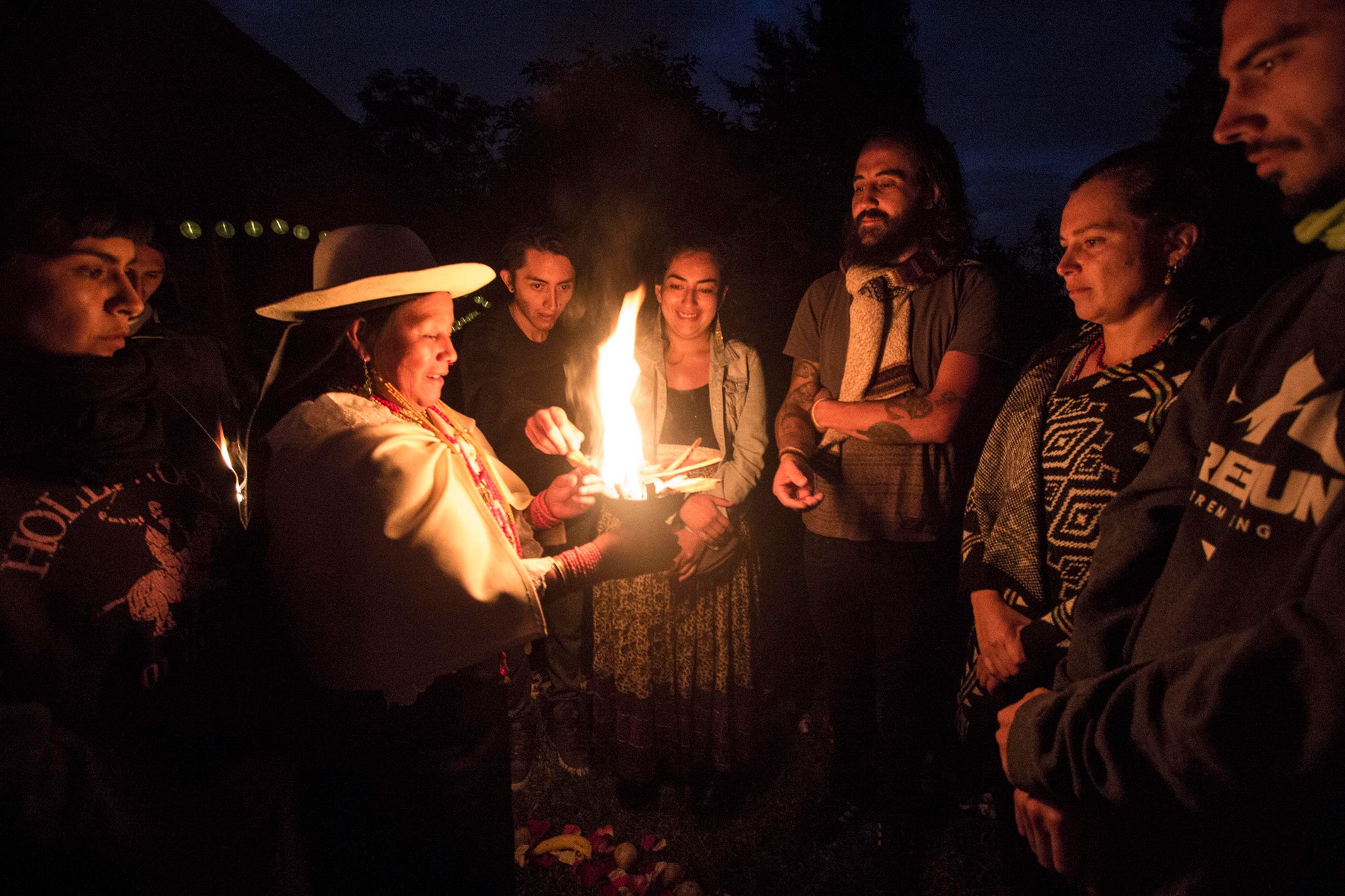An Embodied Experience of Space-Time
06/16/2022
José Luis Macas Paredes (Quito, Ecuador, 1983) is a visual artist, professor, and researcher whose practice integrates the specificities and the poetics of territories in site-time-specific actions. In his work, he applies the indigenous Andean concepts of pacha (space-time), tinku (proportional encounter), and yanantin (complementary parity) to the here and now of cities to project new possible cartographies. Attending to inner resonances with the life that is present in the places, he creates ritual relations connected to specific localities, mediated by phenomena of planetary scale.
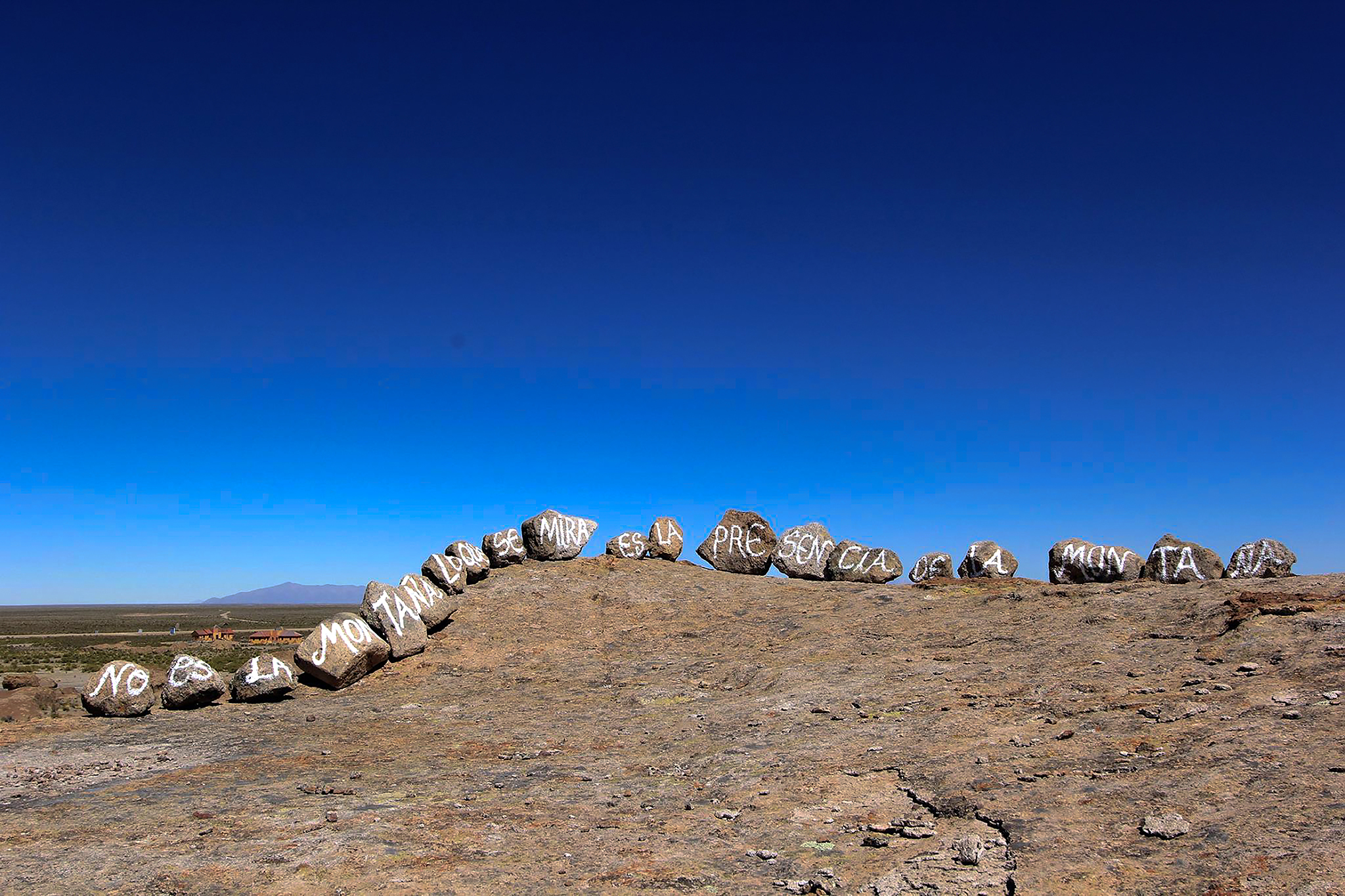
Education
Schooling
I first studied drawing and painting, and later I specialized in Art in Public Space and Multimedia at the Royal Academy of Fine Arts in Brussels. There, I started to develop works in mediums such as audiovisual arts, photography, installation, action art, and relational art. Currently, I am a professor and researcher at the School of Visual Arts of the Catholic University of Ecuador, and I coordinate 'Chawpi laboratorio de creación' [Chawpi Creative Lab], a cultural space located in Quito. Learning is constant and valuable in these two spaces.
In my artistic path, I have met people who have made an impression on me. Starting with my own family and their love for the Andean landscape, its identity and cultural contexts. When I was beginning to study art, around 2002, I met the Ecuadorian poet Raúl Arias, who was part of the Tzántzicos1 group; this opened up the relationship between art, poetry, and politics for me.
In 2008, I joined the Art in Public Space workshop at the Academy of Fine Arts in Brussels, where I came across the artist-teachers Guy Massaux and Aram Mekhitarian. They led me to focus on more experimental paths such as video art, performance, artistic research, and especially, site-specific practices. I think it is from there that emerges a practice that recognizes places, their geography, cities, memories, and the life that is interwoven as a constant source of learning.
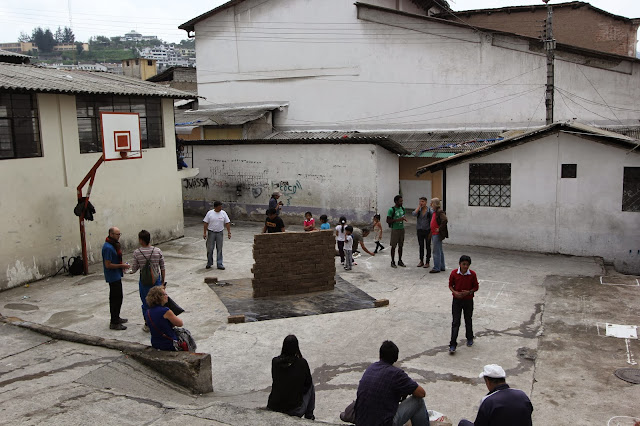


Teaching
I have learned to attach great importance to communication. To listen and know how to identify the singular within the collective in order to create a climate of self-knowledge, trust, mutual support, and commitment to creativity throughout the processes, inside and outside the field of art. To question authoritarian, monocultural and unidirectional educational models, emphasizing the importance of ethical freedom. Regarding the role of art and artists in society, to see it with critical eyes, subvert it through poetics, or transform it by associating itself with diverse causes.
On the other hand, educational practices can contribute to art in developing didactic dynamics and learning experiences linked to geographical, historical, and cultural contexts. Situated, emancipatory, affective, and diverse didactics, capable of transcending the classroom space and recognizing nature as an enormous creative source.
If didactics can be seen as an "art of teaching," its creative expansion could favor the activation of artistic thinking, which sharpens intuition and enriches problem-solving skills. From this perspective, the relationship between education and art lies in creating individual and collective experiences where the sensory is combined with reflection and emotions, looking to balance manual and corporal labor with the production of ideas, meanings, and poetics. In my case, this means emphasizing the materiality, cosmogonies, and ecologies of places.



Learning
When I was studying in Brussels, together with four other Latin American friends, we founded the Mediateca del Sur association. We organized diverse Latin American cultural events through a library, exhibitions, recitals, a film club, and theme parties. The association operated for five years in a building occupied by several citizen collectives belonging to the squatting and housing rights movement. The project was called 123 Rue Royale after its location. In that seven-story building worked and lived about 70 people with more than 20 different nationalities, it was a mosaic of a fairly broad and complex social fabric of many artists and people linked to various activisms. This experience with self-management nurtured me enormously, as it also implied participating in a cultural organization that operated on the margins of institutionalism. We gave thought to ways of identifying what you negotiate, or not, with the establishment and the complexity in reaching a balance to sustain collective processes in the long term.
Another interesting experience came from an invitation made by a colleague of mine at the Catholic University of Ecuador, the professor and artist Jaime Sánchez. In 2015, at the School of Visual Arts, we produced a series of video documentaries about contemporary artists from Ecuador. The aim was to create an archive that would serve as a source of research on contemporary Ecuadorian art and an educational tool for art students. The project was called ‘Index, conversaciones de arte contemporáneo’ [Index, Contemporary Art Conversations] and it involved students since its inception. It was an educational process from the valuable practice of approaching the artists, interviewing them in their creative spaces, and learning from their own voices how they have directed their work.
In La Paz, Bolivia, I met the Ch'ixi collective and the Bolivian sociologist, filmmaker, and activist Silvia Rivera Cusicanqui in 2015, in the Sociology of the Image workshop at the Taller de Historia Oral Andina [Andean Oral History Workshop - THOA]. For Ch'ixi, intellectual work goes hand in hand with doing, from urban gardens to gastronomy, and they integrate the ritual calendar of the main Andean festivities of the region. They also combine self-management with emancipatory educational practices where the role of art allows them to experience the theory, embodying and transforming it into memories to directly affect the community where it emerges and those with whom it engages. Getting to know them was fundamental for me; afterward, I opened Chawpi creative lab in Quito, in 2016, which I coordinate to the date.
Processes
Questions
My projects have gradually become more site-time specific, taking this category from the Kichwa concept of pacha (space-time). At first, I made interventions without following up on them; I now include these observation periods and timeframes in order to be able to understand how the interventions affect their visual environment and, thus, how other ways of embodying the landscape emerge.
Intuition is important in the first approach, listening to our inner voice and the voices of the places, of the life present in them. Doubt emerges as experimentation unfolds and the project begins to take on a life of its own.
For example, my research on the relationship between the urban layout of downtown Quito with the surrounding geography during solstices and equinoxes began in 2013. I was initially unaware of how meteorology greatly determines visibility during these dates. I have hesitated many times whether to give closure to the project with the images I have been able to collect so far. But then the materials and the interconnections between them begin to generate new meanings and a life of their own.
The learning lies in balancing doubt with those initial findings that, in a way, nurture the patience that any durational process requires. For this project, I have decided to wait a few more years to be able to include the "mistakes," which are the ones that teach us what works and what does not.
Strategies
During the pandemic confinement, I worked a lot on notebooks, to the point that I feel that they became my studio. I understood that many things start there. I do not have a systematic methodological organization; I am more of a follower of the principles of relating and bonding with places and subjects. The walkabouts show me where to intervene or not, with what materials, and how to carry out the work.
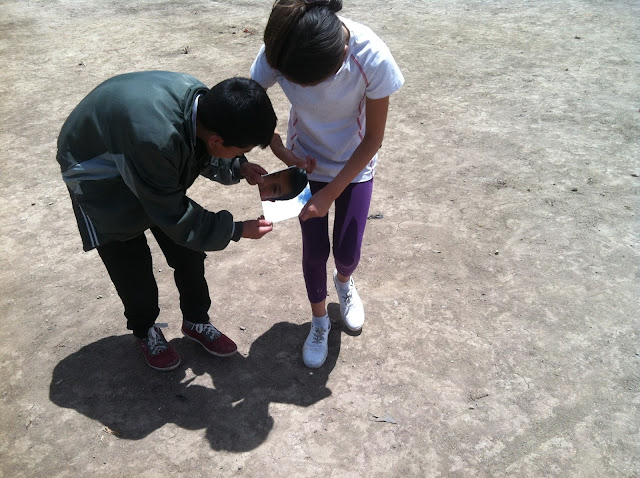


Procedures
I take walkabouts where I take photographs and keep a notebook to jot down or draw the elements whose presence resonates — whether because of the material, form, or some connection linked to my memory. When I develop projects in mountains or archaeological sites, I make offerings to the different life forms and dimensions that inhabit those places, to be able to enter them and perceive how they seek to materialize and transform themselves in the present. This ritual economy with the environment has become something that increasingly permeates my ways of relating. From this practice arises a reflection on how to weave territories and poetics from situated actions to obtain new ways of mapping. The project Ayni/Trans-acción - Acuerdo de Trueque [Ayni/Trans-action - Barter Agreement] (2018), presented at the 10th SIART Biennial in Bolivia as part of a textile laboratory, was a first example of this.
Once the project has begun, when there is a clear idea and a direction for it, I do research from approaches such as orality, material history, geography, poetry, indigenous ancestral wisdom, and so on. I try to maintain as much as possible the balance between empirical research (collecting samples or materials, revisiting places), artistic creation, and connecting ideas that incorporate new meanings to the initial materials and experiences.
Then there is a process of assembly because many of my projects encompass several pieces and different media that complement each other. Thus, their display becomes a device where the possibility of experiencing the place and its underlying stories becomes, in the best of cases, a first-hand experience and poetics for the viewers and participants of the exhibition.
Dialogues
In collaborative works, it is important to clearly outline the reasons for the collaboration and the mutual benefit implied in the agreements. This ethical dimension is essential to avoid replicating practices of cultural or epistemic extractivism, which are very common when working on-site.
We often have an audiovisual documentation team of three or four collaborators for these participatory actions. I find it interesting to think about how to approach the presence of cameras in this type of experience. I incorporate something that comes from the performing arts, which is the "technician-performer." This allows including documentation from the point of view of a "performing" camera besides other more passive ones. Of course, this requires a minimum script to organize the rhythm and resources of the production. Thus, the technical involvement is approached experimentally and creatively.
I usually take on the post-production, except in a couple of cases where I worked with video and audio editors to finalize the works. It is necessary to weave and maintain a network of collaborators and properly remunerate the work of the other people who are part of the project.
Projects
In Progress
I am currently working on an exhibition at the N24 gallery in Quito, which is part of the Cromotopos2 series. It consists of several urban interventions that have the purpose of activating pre-Columbian equatorial astronomical symbology through sunlight. It is a project based on observation and the horizontal geoastronomical study of the apparent path of the Sun — its rising and setting — in relation to the current urban layout of downtown Quito and its surrounding mountains, through shadows projected as a kind of "light stencils" that are activated specifically during solstices and equinoxes.
Cromotopos embodies the notion of ‘site-time-specific,' in the sense of the activating sunlight during the equinox. By applying the Andean concepts of pacha (space-time), tinku (proportional encounter), and yanantin (complementary parity), it seeks to bring to the present, to the here-and-now, historical ancestral knowledge and aesthetics through abstraction and projection. In the words of Cecilia Fajardo Hill, bringing them into the everyday life of the city poses "a counterpoint to its history, without denying its colonial condition but influencing it in a critical way. Somehow, it seeks to deconstruct Western modernism, which has placed abstraction within a progressive white discourse."3
In Retrospect
Working on solstices and equinoxes has been a comprehensive learning process. On the one hand, synchronizing with the time of the Sun in relation to the Earth and acknowledging the Andean indigenous legacy: their technologies for understanding, inhabiting, and celebrating time-space; the agro-festive calendars are an example of this. On the other hand, having an embodied experience of the landscape as an event mediated by the relationship between sunlight, its temporality, the mountains, and the city.
This research is entitled Recorridos de luz y sombra, ceques solares de Quito [Paths of Light and Shadow, Solar Ceques4 of Quito]. It employs walking and cyanotype photography to evidence the axes of the apparent movement of the Sun on the urban layout of the city center. These photographs are developed a year later with the particular brightness and angle of reflection of the sunlight on such specific dates. In this sense, it means to think of the light itself as the bearer of the image, and its gestation time obeys a temporality that contrasts with the current globalized frenzy. It takes beyond-human time scales to grasp certain all-embracing understandings of life.
This has undoubtedly determined my way of working, for although these things have their epicenter in a specific locality, they are mediated by phenomena of planetary scale. On the other hand, understanding the light during solstices or equinoxes differs at the zero parallel or at the poles; the same event manifests itself differently, depending on where it is experienced. I find it interesting to identify global similarities and differences in this type of phenomena.
Contexts
My body of work is mainly based on situated contexts: the geographical-astronomical-cultural specificities of a place. The issue of public space is undoubtedly there as well, especially in the project Borradores [Erasers] (2014-2019), which resorts to graffiti as a gesture to intervene smog-stained walls. Using an eraser as a tool for drawing, we made visual comments highlighting the crisis of extractivist models, thus turning these walls into critical spaces to generate meanings.
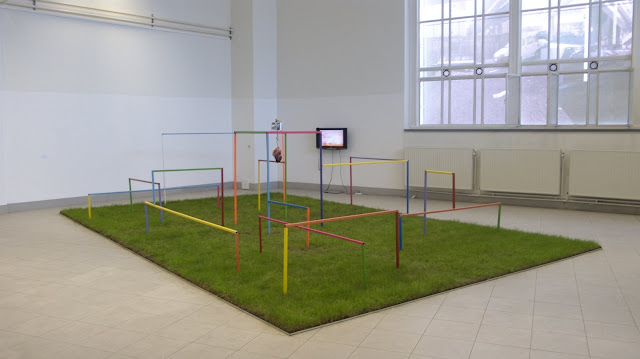
Further Reflections
Currently, artists education must assume the challenges of the effects of the pandemic — speaking from a context where the art market is reduced, as is the private and institutional patronage. Also, at a time when the idea of entrepreneurship is on the rise, which in many cases makes things even more precarious and evidences the lack of labor rights and social security for artists and cultural workers. Both education and practices must consider the economy in its mercantile sense and in the management and flow of creative resources.
To be able to see art beyond the mere production of objects and include the articulation and strengthening of relationships too. Opting for models based on cooperation and mutual support will continue to be alternatives to the crisis.

